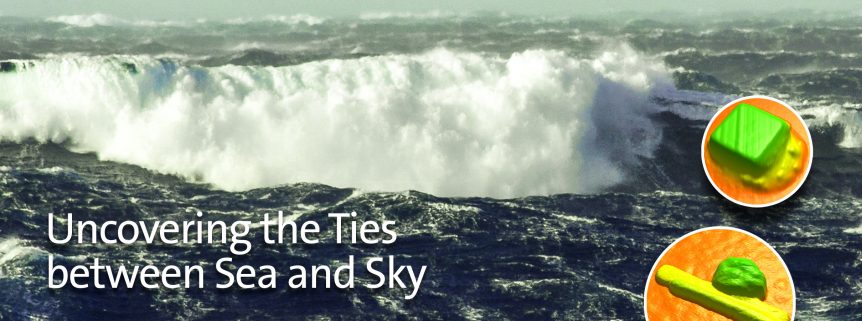CAICE scientists are continuing to show the critical importance of chemistry within the impact of aerosol particles on our climate. Two important articles have been published by our team in the American Chemical Society’s new flagship journal, ACS Central Science that strike at two key issues.
In order to put accurate aerosol chemistry in to climate models, scientists need to reference the production of aerosols in the model to a measurable quantity – ideally, a quantity that can be measured by satellite. Chlorophyll-a, the green pigment of oceanic algae (also found in green plants on land), was proposed to have a relationship with the amount of organic material that was associated with sea spray aerosol. Recent, more detailed, observations indicate that this relationship may not have been as strong or reliable as once was thought – causing a major problem for climate modelers! Through studies that CAICE performed at the wave channel air-sea interaction facility, located at Scripps Institution of Oceanography, our team was able to identify the direct chemical link between algae and organic material in sea spray aerosol. As the article describes, “a delicate balance between the rate of [algae] primary production of labile lipids and enzymatic induced degradation” is at the heart of the transfer mechanism of algae-produced organic material in the ocean and what is then able to transfer to the atmosphere within sea spray aerosol. Understanding the chemical mechanism for this process will help the scientific community to improve the mathematical relationship between observable changes in the environment and the chemistry of aerosols in climate models so that we can better predict future climate and better understand the role of sea spray aerosols in forming clouds.
On the topic of clouds, CAICE has been coming to understand how aerosols influence clouds in a detailed way. Prior work by our team has shown that the ability of sea spray aerosols to affect cloud droplet formation is rooted in the composition of each individual particle — there are two important types of sea spray particles that exist in terms of cloud droplet formation: those that contain sea salt, and those that do not. When the proportions of these two particle types change, this affects the ability of sea spray to affect clouds, but when just the composition of the salty type of particle changes, there is little influence on clouds. In this issue of ACS Central Science, the CAICE team was able to show a clever way to measure this effect directly, without actually needing to measure the chemical composition of the particles themselves! This will help expand the level of detail available to routine measurements of aerosol-cloud interactions both in laboratory and field experiments.

